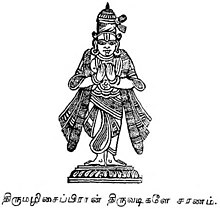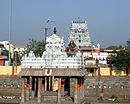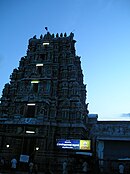Tirumalisai Alvar
Tirumalisai Alvar | |
|---|---|
 | |
| Title | Alvar |
| Personal | |
| Born | Thirumalisai |
| Religion | Hinduism |
| Organization | |
| Philosophy | Vaishnavism |
| Religious career | |
| Guru | Vishvaksena |
| Literary works | Tiruchanda Viruttam,Nanmukan Tiruvantati |
Tirumalisai Alvar(IAST:Tirumaḻisai; Born: Bhargavar 4203 BCE -297 CE) is aTamilsaint revered in theSri Vaishnavismschool of south India, inTondai Nadu(now part ofKanchipuramandTiruvallurdistricts). He was born in 4203 BCE.[1][2]The legend of this saint devotees of Sri Vaishnavism believe that he was the incarnation ofVishnu's disc,Sudarshana.He is believed to have been born at theJagannatha Perumal temple, Tirumalisai,by "divine grace".
Historically, Tirumalisai Alvar is regarded to have been the son of a sage.
Alvars[edit]
The wordAlvarmeans the one who dives deep into the ocean of the countless attributes of god.Alvarsare considered to have been the twelve supreme devotees ofVishnu,who were instrumental in popularisingVaishnavismin South India. The religious works of these saints inTamil,songs of love and devotion, are compiled asNaalayira Divya Prabandhamcontaining 4000 verses and the 108 temples revered in their songs are classified asDivya desam.[3][4]The saints had different origins and belonged to different castes. As per tradition, the first threeAlvars,Poigai, Bhutha and Pey were born miraculously. Tirumalisai was the son of a sage, Thondaradi, Mathurakavi, Periyalvar and Andal were from theBrahmincommunity, Kulasekhara fromKshatriyacommunity, Nammalvar was from a cultivator family, Tirupana from thepanarcommunity and Tirumangai fromkalvarcommunity.Divya Suri Saritraby Garuda-Vahana Pandita (11th century CE),Guruparamparaprabavamby Pinbaragiya Perumal Jiyar,Periya tiru mudi adaivuby Anbillai Kandadiappan,Yatindra Pranava Prabavamby Pillai Lokacharya, commentaries onDivya Prabandam,Guru Parampara (lineage of Gurus) texts, temple records and inscriptions give a detailed account of theAlvarsand their works. According to these texts, the saints were considered incarnations of some form of Vishnu. Poigai is considered an incarnation ofPanchajanya(Krishna's conch), Bhoothath ofKaumodakee(Vishnu's Mace/Club), Pey ofNandaka(Vishnu's sword), Thirumalisai ofSudarshanam(Vishnu's discus), Namm ofVishvaksena(Vishnu's commander), Madhurakavi ofVainatheya(Vishnu's eagle, Garuda), Kulasekhara ofKaustubha(Vishnu's necklace), Periy of Garuda (Vishnu's eagle), Andal of Bhoodevi (Vishnu's wife, Lakshmi, in her form as Bhudevi), Thondaradippodi ofVanamaalai(Vishnu's garland), Thiruppaan ofSrivatsa(An auspicious mark on Vishnu's chest) and Thirumangai ofSaranga(Rama's bow). The songs ofPrabandamare regularly sung in all the Vishnu temples of South India daily and also during festivals.[4][5]
Early life[edit]
The name of the Alvar comes from his birthplace,Tirumalisai,a suburb in modern-dayChennai.[6] The Alvar was born to Bhargava maharishi and an apsara, Kanakangi, after an unusual 12 months stay in the womb. The foetus came out as just a lifeless lump of flesh with no arms and legs. The couple were terribly depressed and with unwillingness left it under a bamboo bush and proceeded with their spiritual journey. Vishnu appeared with Lakshmi and blessed the "flesh" with their kataksham and it turned into an lively human being.
He was later picked up with both the arms affectionately by a tribal named Thiruvalan. A really blessed couple Thiruvalan and pankajavalli, was overwhelmed by the grace of god for this gift of a baby. The boy grew on to become Tirumalisai Alvar. He also has an eye on his right leg. He lived up to 10 years of age in a hamlet near Tirumalisai village named as Pirayampathu. This Alvar was an incarnation of Sudarsana Chakra ( the divine discus of Lord Vishnu).
Tirumalisai Alvar decided to learn about all other religions. He also got initiated into Vaishnavism by Pey Alvar. After visiting several temples, he reached Tiruvekka, the birthplace of Poigai Alvar.
Displeasing the Pallava king[edit]
Legend also says that when Kanikannan, his disciple displeased thepallavaking for not agreeing to restore the king's youth. Earlier on he granted youth to an old unmarried maid of the temple. The king married that woman but he himself was an old man and thus wanted to enjoy life as a youth with his new wife. Tirumalisai refused him and the king decided to banish him. Tirumalisai Alvar asked the God from the temple,Yathotkari,to leave with him.
Tamil
கணிகண்ணன் போகின்றான் காமரு பூங் கச்சி
மணிவண்ணா! நீ கிடக்க வேண்டா
செந்நாப் புலவனும் போகின்றேன் நீயும் உன்றன்
பை நாகப்பாயை சுருட்டிக் கொள்
Transliteration
KanikaNNan Poginraan Kaamaru poong Kachi
ManivaNNaa! Nee Kidakka Vendaa
Sennaap Pulavanum Poginren Neeyum Unran
Pai Naagappaayai Suruttik KoLL
KanikaNNan is going out of kAnchi Oh! Manivanna!, You don't have to lie here anymore. Since, as the fluent poet that I am also leaving with him, you also roll your serpent bed and follow me "And, accordingly all of them left KAnchipuram
Vishnuis said to have rolled up the snakeSeshalike a mattress and left with him.
Mangalasasanam[edit]
There are 216 of his paasurams in the 4000Divya Prabhandham.His firstPrabandhamnamedTiruchanda Viruttamcontains 120 hymns and starts from 752paasuramand ends at 871paasuram.The secondPrabandhamof Tirumalisai Alvar is titledNaanmugan Thiruvandhadhiand it contains 96 verses. The work ofNaanmugan Thiruvandhadhistarts from 2382 paasuram and ends at 2477 paasuram.
He has sung in praise of 20 temples.[7]
| S.No. | Name of the temple | Location | Photo | Presiding deity | Notes/Beliefs |
|---|---|---|---|---|---|
| 1 | Thiru Kapistalam | 10°56′46″N79°15′22″E/ 10.946°N 79.256°E | |||
| 2 | Thiru Anbil[8] | Anbil Tiruchirappalli district 10°52′N78°53′E/ 10.86°N 78.88°E |
 |
Sundararaja Perumal Azhagiya Nambi Perumal |
The temple is located on the Northern bank of the riverKollidam,at a distance of 25 km (16 mi) fromTrichy.KingSundara Cholawho ruled the area was a devotee of the temple and during each of his innumerable victories in wars, he showered a lot of wealth on this temple. His prime minister Anirudha Brahmarayar is believed to be from Anbil, the village where the temple is located. The copper plates having the records from the Chola period from Anbil indicate generous contribution from theMedieval Cholasindicate various gifts to the temple.[9][10] |
| 3 | Thiruevvul[8] | 13°08′35″N79°54′25″E/ 13.143°N 79.907°E |  |
||
| 4 | Thiruuragam[11] | 12°50′20″N79°42′18″E/ 12.839°N 79.705°E |  |
||
| 5 | Thiruvallikeni[12] | 13°03′14″N80°16′37″E/ 13.053884°N 80.277020°E |  |
||
| 6 | Thirupper Nagar | 10°50′21″N78°53′21″E/ 10.839282°N 78.889070°E | |||
| 7 | Thirukkurungudi[13] | 8°26′10″N77°33′57″E/ 8.436096°N 77.565933°E |  |
||
| 8 | Tiruvekkaa[14] | 12°49′26″N79°42′43″E/ 12.824°N 79.712°E |  |
||
| 9 | Tiruppatakam[15] | 12°50′31″N79°41′46″E/ 12.842°N 79.696°E |  |
||
| 10 | Thirukoshtiyur[16] | 10°03′36″N78°33′36″E/ 10.060°N 78.560°E |  |
||
| 11 | Thirukkudandhai[16] | 10°57′32″N79°22′30″E/ 10.959°N 79.375°E |  |
||
| 12 | Thiruvenkadam | 13°41′00″N79°20′51″E/ 13.683304°N 79.347406°E |  |
||
| 13 | Tirupparkatal |  |
|||
| 14 | Srirangam | Srirangam,Trichy district Tamil Nadu 10°51′45″N78°41′23″E/ 10.8625°N 78.689722°E |
 |
Ranganayagi Ranganathar (Periya Perumal) |
Srirangam temple is often listed as the largest functioningHindu templein the world, the still largerAngkor Watbeing the largest existing temple. The temple occupies an area of 156 acres (631,000 m²) with a perimeter of 4,116m (10,710 feet) making it the largest temple in India and one of the largest religious complexes in the world.[17][18]The annual 21-day festival conducted during the Tamil month ofMargazhi(December–January) attracts 1 million visitors.[19] |
| 15 | Azhagar Kovil[13] | 10°04′26″N78°12′47″E/ 10.074°N 78.213°E |  |
||
| 16 | Appakkudathaan Perumal Temple[13] | Koviladi,Trichy district Tamil Nadu 10°52′N78°53′E/ 10.86°N 78.88°E |
 |
Indravalli Appala Ranganatha Perumal |
The temple has inscriptions from the 18th year of the reign ofAditya Chola.[20]The recorded inscriptions in this temple are numbered 283, 300, 301 and 303 of 1901.[21]The temple is one of the fivePancharanga Kshetrams(also calledPancharangams,
meaning the "five Rangams or Ranganathas" ), a group of five Hindu temples on the banks of theKaveri Riverdedicated to Ranganatha, a form of Vishnu.[22][23] |
Notes[edit]
- ^L. Annapoorna (2000).Music and temples, a ritualistic approach.p. 23.ISBN9788175740907.
- ^Sakkottai Krishnaswami Aiyangar (1911).Ancient India: Collected Essays on the Literary and Political History of Southern India.pp. 403–404.ISBN9788120618503.
- ^Rao, P.V.L. Narasimha (2008).Kanchipuram – Land of Legends, Saints & Temples.New Delhi: Readworthy Publications (P) Ltd. p. 27.ISBN978-93-5018-104-1.
- ^abDalal2011, pp. 20-21
- ^Ramaswamy, Vijaya (2007).Historical Dictionary of the Tamils.Scarecrow Press. p. 211.ISBN9780810864450.
- ^Ramakrishna Mission (1998).Bulletin of the Ramakrishna Mission Institute of Culture.Vol. 49. The Institute. pp. 535–538.ISBN9780670083282.
- ^Pillai, M. S. Purnalingam (1904).A Primer of Tamil Literature.Madras: Ananda Press. pp. 182–83.ISBN9788120609556.
- ^abKodayanallur Vanamamalai2001, p. 51
- ^"Sri Sundararaja Perumal temple".Dinamalar.Retrieved9 September2013.
- ^Ayyar, P. V. Jagadisa (1982).South Indian Shrines: Illustrated.New Delhi: Asian Educational Services. p. 533.ISBN9788120601512.
- ^Kodayanallur Vanamamalai2001, p. 52
- ^T.2002, p. 85
- ^abcKodayanallur Vanamamalai2001, p. 59
- ^Kodayanallur Vanamamalai2001, p. 70
- ^T.2002, p. 86
- ^abKodayanallur Vanamamalai2001, p. 58
- ^Mittal, Sushil; Thursby, G.R. (2005).The Hindu World.New York: Routelge. p. 456.ISBN0-203-67414-6.
- ^Vater, Tom (2010).Moon Spotlight Angkor Wat.USA: Perseus Books Group. p. 40.ISBN9781598805611.
- ^Jones, Victoria (2004).Wonders of the World Dot-to-Dot.New York: Sterling Publishing Co., Inc. p. 4.ISBN1-4027-1028-3.
- ^Jouveau-Dubreuil, Tony (1994).The Pallavas.New Delhi: Asian Educational Services. p. 77.ISBN81-206-0574-8.
- ^Jouveau-Dubreuil, G. (1994).Pallava Antiquities – 2 Vols.Asian Educational Services. p. 13.ISBN978-81-206-0571-8.
- ^S., Prabhu (16 September 2010)."Restoring the glory of a temple".The Hindu.Retrieved9 September2013.
- ^Soundara Rajan, Kodayanallur Vanamamalai (2001).Concise classified dictionary of Hinduism.New Delhi: Concept Publishing Company. p. 65.ISBN81-7022-857-3.
References[edit]
- B. S., Chandrababu; S., Ganeshram; C., Bhavani (2011).History of People and Their Environs.Bharathi Puthakalayam.ISBN9789380325910.
- Chari, S. M. Srinivasa (1997).Philosophy and Theistic Mysticism of the Āl̲vārs.Motilal Banarsidass Publishers.ISBN9788120813427.
- Dalal, Roshen (2011).Hinduism: An Alphabetical Guide.Penguin Books India.ISBN9780143414216.
- Kodayanallur Vanamamalai, Soundara Rajan (2001).Concise classified dictionary of Hinduism.New Delhi: Concept Publishing Company.ISBN81-7022-857-3.
- T., Padmaja (2002).Temples of Kr̥ṣṇa in South India: history, art, and traditions in Tamilnāḍu.New Delhi: Shakti Malik.ISBN81-7017-398-1.
